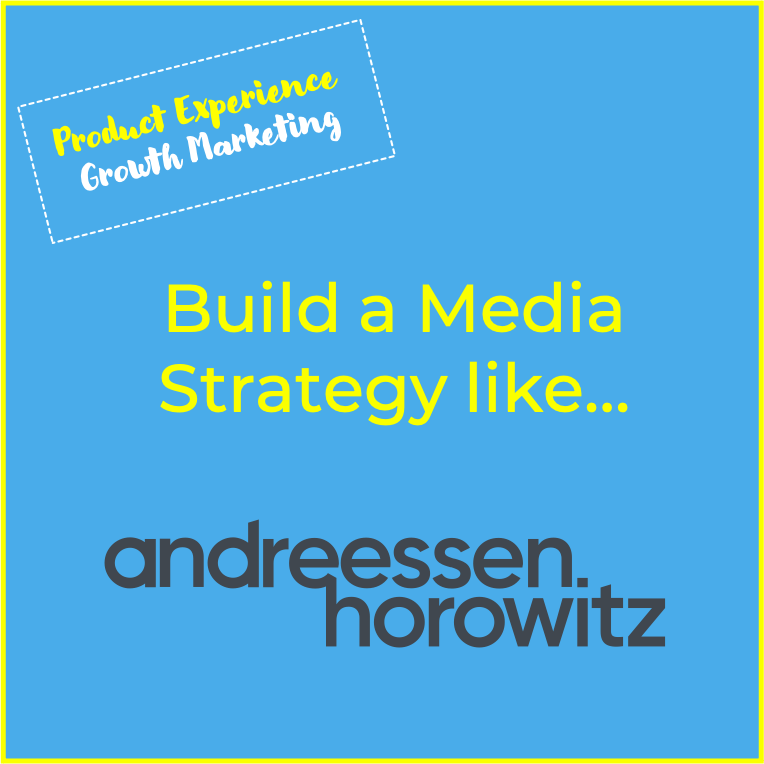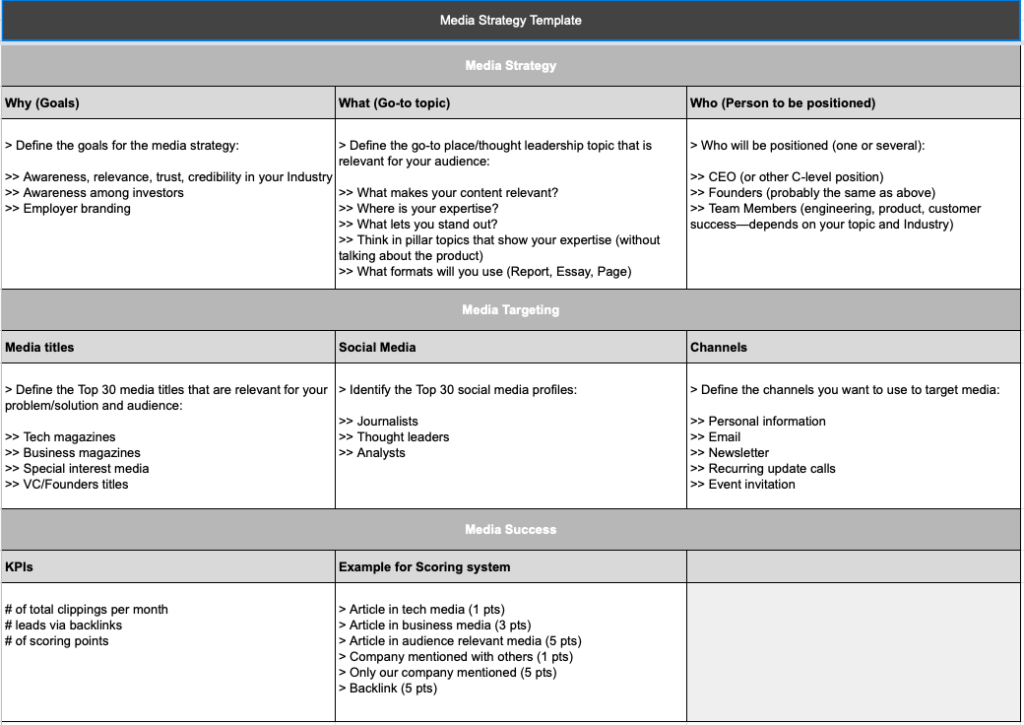Today, we have a look at Andreessen Horowitz’s (A16Z) media strategy. Yes, we learn from an investor how to build a media and PR strategy for brand and growth. A16Z is not the biggest investor, nor the one with the most exits. But one can say without exaggeration that it is the best-known Silicon Valley VC. And there’s a reason for it.

Why startups should consider media and PR for their growth plan
Maybe to start with: you don’t need to be in TechCrunch to build a successful startup. But media coverage and public relations can help in many ways, and there’s a lot more to discover like tech magazines.
Many technical founders, academics, and other experts often believe that great products — or great ideas! — sell themselves, without any extra effort or marketing. But in reality, they often need PR
A16Z. Intro description from the podcast episode “Brand Building Ideas…and People
Here’s a list of things you can expect when you use media and PR:
- Your prospects are aware of your solution and learn how they can solve their problem
- Gives you credibility in your audience while most of the own stuff is seen as advertising
- Positions your CEO, founders and team members and shows that you are the domain experts—and go-to place—for your topic
- Let’s you control your own story—you must define how others talk about you and media is a great amplifier
- Helps to build your brand and tell your story for awareness, visibility and relevance
- Makes investors and advisors aware of your company and product
- Helps you with visibility for recruiting the best talent
How can startups learn from Andreessen Horowitz?
1. Positioning of founders and team members in own and media channels
In 2009, Marc Andreessen and Ben Horowitz founded their first fund, right after the financial crisis. Marc announced the launch in an interview with Charlie Rose on CBS. This was followed by cover stories on Fortune and appearances at their annual tech conference, which brought the two founders and investors enormous attention. All of this was organized behind the scenes by Margit Wennmachers, one of the most influential media and PR people in Silicon Valley (and later hired as A16Z’s Operating Partner).
The media and content presence of A16Z started with Marc, who was already known for his own startups as well as his Facebook investments. Later Ben Horowitz, joined in and created a position around entrepreneurship and culture and change with numerous books.
Meanwhile, numerous partners are present in different areas and provide for the image of the company and the massive awareness in the tech and startup world. Whether it’s Chris Dixon who covered AR/VR early on, Scott Kupor with his book on the VC world, or Andrew Chen who focuses on B2C—to name only a few.
While the founders have a special status and are usually the first in demand in the media, the partners position themselves as experts in their specialties. They create a lot of media buzz and funnel traffic through the own channels.
2. Thought leadership pieces to become the go-to place for your topic
Marc Andreessen recognized the potential of media and PR early on. In a Wired article, he mentioned that the signal he wants to send is that “if you’re an engineer or an entrepreneur trying to build something fundamentally new we want you to come to us because we’re the people who understand this stuff.” His goal was to define the agenda for tech’s future.
While the individuals are the rocket, the content is the fuel on its way to thought leadership. In 2011, Marc’s first version of “Software is eating the world” was published, one of the most successful thought leadership pieces and op-eds about the importance of tech and software. And something like “eating the world” can be re-used in the messaging like “aaS” what you can see when you have a look at the content on the “Bio” page:

During the pandemic in 2020, Marc published a provocative article titled “It’s time to build” which is meanwhile an important part of the messaging.

Ben Horowitz is a thinker and shows his expertise in a natural way without any starry airs. In his book “The Hard Thing about Hard Things”, he shares a lot of his experiences around entrepreneurship in tech. Meanwhile, the online content library is probably as big (or even bigger) as the 800-book library in the firm’s lobby.
3. Media relationsships and community building
We talked about the people story and the content. The third ingredient is the channels and communities to share the message and use media as a massive amp.
The A16Z team distributes the topics in many ways: appearances of the founders and partners at conferences, social media, Reddit, Substack, Clubhouse—and in the own channels. In the first years, media played the most important role to get Andreessen Horowitz a hall-of-fame-status as Silicon Valley VC.
Not only startups desire to appear on TechCrunch, Wired or Business Insider—VCs aim for it too. Media relations is less about coming up with the one-off super story and more about building a relationship with journalists and understanding the give-and-take principle. Margit Wennmachers was able to build on her existing media contacts from founding her own PR agency. So she could offer Marc and Ben as well as other partners as experts which was gratefully accepted as input by the media.
Another milestone was bringing Sonal Chokshi from Wired to the firm. Sonal has played a significant role in the success of the company’s own channels, especially the podcast. This was the first step to strengthen own channels to control the story. In more than 500 podcast episodes, A16Z partners, as well as external guests, talk about tech and startups.
From VC to Media Company
The VC Company is increasingly transforming itself into a media company. In 2020, it invested in the voice-only social startup Clubhouse, where many of the first rooms were opened by A16Z (close) employees and more than 50 team members are currently active. Most recently, Andressen Horowitz led a 65 million round in Substack.
👇 Some news:
— Andrew 🇺🇸 (@andrewchen) January 24, 2021
I've led a16z's new investment in Clubhouse and have joined the board. Essay below that covers:
– how I know founders @pdavison @rohanseth
– why we're excited to invest
– how we think Clubhouse is unique – particularly for creators!https://t.co/2t1Uzj2uJ4
Announcement:
— Andrew 🇺🇸 (@andrewchen) March 30, 2021
A16z is leading Substack’s $65M Series B! This is one of my favorite startups on many levels, as a writer/author. I’m proud to be an investor 😎
The funding will be used to provide deeper value for writers on the platform. Details:https://t.co/EVE8SxhMWG
Both deals involved General Partner Andrew Chen, who now has a strong focus on content and also publishes himself. Partners such as Andrew Chen, David Ulevitch and Martin Casado are building their own community cosmos. This helps A16Z with distributing its own content and tell the right story.
Quick summary of the milestones
- Positioning of the founders with stories in launch interviews
- Thought leadership content pieces as rocket fuel
- Media as key amplifier for the topics
- Key team members positioning as domain experts
- Podcast as first key driver besides the blog
- Clubhouse and Substack are the new pieces in the puzzle
How to build your simple but scalable media and PR strategy
- Define the goals for the media strategy:
- Awareness, relevance, trust, credibility in your Industry
- Awareness among investors
- Employer branding
- Identify media titles and journalists depending on your goals
- Tech media (TechCrunch, Wired)
- Business titles (Business Insider, Wall Street Journal)
- Special interest media (finance, manufacturing, marketing, education)
Who do you position?
- CEO (or other C-level position)
- Founders (probably the same as above)
- Team Members (engineering, product, customer success—depends on your topic and Industry)
What is your “Go-to Topic”?
- What makes your content relevant?
- Where is your expertise?
- What lets you stand out?
- Think in pillar topics that show your expertise (without talking about the product)
- Define topics and stories that are relevant for the audience
How do you tell it to the world?
- Comment on articles about your topic (you’ll be surprised how well that works)
- Connect to the journalists reporting about your topics and offer your perspective or expertise (without talking about the product)
- Build a simple spreadsheet with a media list (or buy one, which is not cheap and most of the time not worth it)
- Feed the journalists with interesting topics and opinions on LinkedIn, Twitter, Reddit, or wherever you feel comfortable (and find your audience)
- Define your own channels:
- Blog and podcast are channels you can handle in the early growth phase
- Scale every piece of content (an article into a podcast, a presentation into an article, etc.)
- Media will grab the content and amplify the stories
- Write articles as a contributor for magazines
Quick start with the Ultimate Growth Map and Templates

Subscribe to my newsletter and follow me on LinkedIn and Twitter.
Dirk Schart is CMO of the No. 1 Enterprise AR startup RE’FLEKT. He is a Product-first Marketing pioneer and focuses on B2B software and SaaS models —from zero to hero. Dirk is the former Director of SaaS Products at HyperloopTT, and helped scale SkyWork from 30 to 200+ in less than 18 months. He mentors startups at the German Accelerator in the Silicon Valley. Dirk is the author of “Augmented and Mixed Reality for Marketing”.
